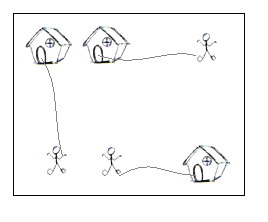题目链接:
POJ:http://poj.org/problem?id=2195
HDU:http://acm.hdu.edu.cn/showproblem.php?pid=1533
Description

Input
Output
Sample Input
2 2 .m H. 5 5 HH..m ..... ..... ..... mm..H 7 8 ...H.... ...H.... ...H.... mmmHmmmm ...H.... ...H.... ...H.... 0 0
Sample Output
2 10 28
Source
题意:
一个N行M列的矩阵,其中“.”代表空地,“H”代表房子,“m”代表人,其中有 n 个房子和 n 个人。
现在要求每个人进入其中的一间房子,且每人每走一步需要支付1美元。
求最小需要花费多少美元能让所有人都进入到房子中(每个人只能进入一间房子,每个房子只能容纳一个人)。
PS:
建立超级源点,分别连接每个m,容量为1,费用0
建立超级汇点,分别把每个H连接到汇点,容量为1,费用为0
再把每个m分别指向H,容量为1,费用为该m到H的横纵坐标之差的绝对值的和,|X1-X2|+|Y1-Y2|;
代码如下:
#include <cstdio>
#include <cstring>
#include <algorithm>
#include <queue>
#include <cmath>
using namespace std;
const int MAXN = 10000;
const int MAXM = 100000;
const int INF = 0x3f3f3f3f;
struct Edge
{
int to, next, cap, flow, cost;
int x, y;
} edge[MAXM],HH[MAXN],MM[MAXN];
int head[MAXN],tol;
int pre[MAXN],dis[MAXN];
bool vis[MAXN];
int N, M;
char map[MAXN][MAXN];
void init()
{
N = MAXN;
tol = 0;
memset(head, -1, sizeof(head));
}
void addedge(int u, int v, int cap, int cost)//左端点,右端点,容量,花费
{
edge[tol]. to = v;
edge[tol]. cap = cap;
edge[tol]. cost = cost;
edge[tol]. flow = 0;
edge[tol]. next = head[u];
head[u] = tol++;
edge[tol]. to = u;
edge[tol]. cap = 0;
edge[tol]. cost = -cost;
edge[tol]. flow = 0;
edge[tol]. next = head[v];
head[v] = tol++;
}
bool spfa(int s, int t)
{
queue<int>q;
for(int i = 0; i < N; i++)
{
dis[i] = INF;
vis[i] = false;
pre[i] = -1;
}
dis[s] = 0;
vis[s] = true;
q.push(s);
while(!q.empty())
{
int u = q.front();
q.pop();
vis[u] = false;
for(int i = head[u]; i != -1; i = edge[i]. next)
{
int v = edge[i]. to;
if(edge[i]. cap > edge[i]. flow &&
dis[v] > dis[u] + edge[i]. cost )
{
dis[v] = dis[u] + edge[i]. cost;
pre[v] = i;
if(!vis[v])
{
vis[v] = true;
q.push(v);
}
}
}
}
if(pre[t] == -1) return false;
else return true;
}
//返回的是最大流, cost存的是最小费用
int minCostMaxflow(int s, int t, int &cost)
{
int flow = 0;
cost = 0;
while(spfa(s,t))
{
int Min = INF;
for(int i = pre[t]; i != -1; i = pre[edge[i^1]. to])
{
if(Min > edge[i]. cap - edge[i]. flow)
Min = edge[i]. cap - edge[i]. flow;
}
for(int i = pre[t]; i != -1; i = pre[edge[i^1]. to])
{
edge[i]. flow += Min;
edge[i^1]. flow -= Min;
cost += edge[i]. cost * Min;
}
flow += Min;
}
return flow;
}
int main()
{
int n, m;
while(~scanf("%d%d",&n,&m))
{
if(n==0 && m==0)
break;
int ch = 0, cm = 0;
init();//注意
for(int i = 0; i < n; i++)
{
scanf("%s",map[i]);
for(int j = 0; j < m; j++)
{
if(map[i][j]=='H')
{
HH[ch].x = i;
HH[ch++].y = j;
}
else if(map[i][j]=='m')
{
MM[cm].x = i;
MM[cm++].y = j;
}
}
}
//printf("ch:%d cm:%d\n",ch,cm);
int beg = 0;//超级起点
int end = 2*ch+1;//超级汇点
for(int i = 0; i < cm; i++)
{
addedge(beg,i+1,1,0);//超级起点,容量为1,花费为0
for(int j = 0; j < ch; j++)
{
int tt = abs(HH[i].x-MM[j].x)+abs(HH[i].y-MM[j].y);
//printf("tt:%d\n",tt);
addedge(i+1,j+1+ch,1,tt);
}
addedge(i+1+ch,end,1,0);//超级汇点容量为1,花费为0
}
int ans = 0;
minCostMaxflow(beg,end,ans);
printf("%d\n",ans);
}
return 0;
}
POJ 2195 & HDU 1533 Going Home(最小费用最大流)
原文地址:http://blog.csdn.net/u012860063/article/details/41792973